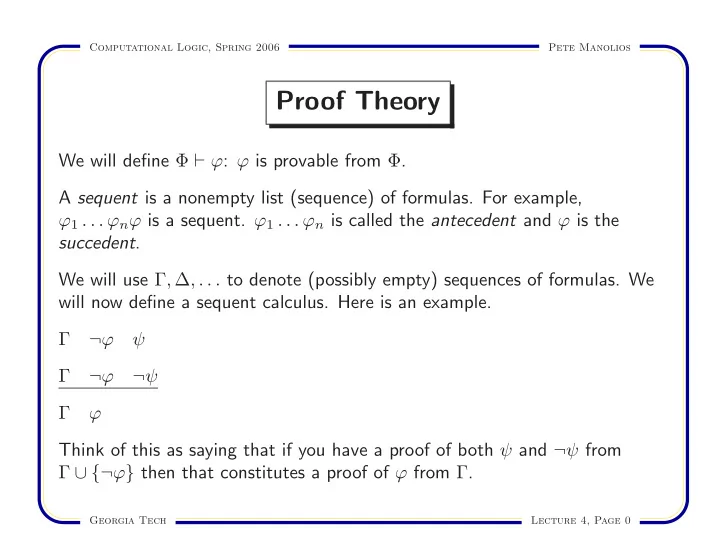

Computational Logic, Spring 2006 Pete Manolios Proof Theory We will define Φ ⊢ ϕ : ϕ is provable from Φ . A sequent is a nonempty list (sequence) of formulas. For example, ϕ 1 . . . ϕ n ϕ is a sequent. ϕ 1 . . . ϕ n is called the antecedent and ϕ is the succedent . We will use Γ , ∆ , . . . to denote (possibly empty) sequences of formulas. We will now define a sequent calculus. Here is an example. Γ ¬ ϕ ψ Γ ¬ ϕ ¬ ψ Γ ϕ Think of this as saying that if you have a proof of both ψ and ¬ ψ from Γ ∪ {¬ ϕ } then that constitutes a proof of ϕ from Γ . Georgia Tech Lecture 4, Page 0
Computational Logic, Spring 2006 Pete Manolios Derivability If there is a derivation of the sequent Γ ϕ , then we write ⊢ Γ ϕ and we say that Γ ϕ is derivable . Definition 1 A formula ϕ is formally provable or derivable from a set Φ of formulas (written Φ ⊢ ϕ ) iff there are finetely many formulas ϕ 1 , . . . , ϕ n in Φ such that ⊢ ϕ 1 . . . ϕ n ϕ . A sequent Γ ϕ is correct if Γ | = ϕ Georgia Tech Lecture 4, Page 1
Computational Logic, Spring 2006 Pete Manolios Sequent Calculus Antecedent Rule (Ant) Γ ϕ if every member of Γ is also a member of Γ ′ . Γ ′ ϕ Assumption Rule (Assm) if ϕ is a member of Γ Γ ϕ Proof by Cases Rule (PC) Γ ψ ϕ Γ ¬ ψ ϕ Γ ϕ Georgia Tech Lecture 4, Page 2
Computational Logic, Spring 2006 Pete Manolios Sequent Calculus Contradiction Rule (Ctr) Γ ¬ ϕ ψ Γ ¬ ϕ ¬ ψ Γ ϕ ∨ -Rule for the Antecedent ( ∨ A) Γ ϕ ξ Γ ψ ξ Γ ( ϕ ∨ ψ ) ξ ∨ -Rule for the Succedent ( ∨ S) Γ Γ ϕ ϕ (a) (b) Γ ( ϕ ∨ ψ ) Γ ( ψ ∨ ϕ ) Georgia Tech Lecture 4, Page 3
Computational Logic, Spring 2006 Pete Manolios Derived Rules Using the existing rules, we can derive new sequents. Tertium non datur (Ctr) ( ϕ ∨ ¬ ϕ ) Proof? We can prove it by assuming ϕ , getting ϕ ∨ ¬ ϕ and repeat with ¬ ϕ . Second Contradiction Rule (Ctr’) Γ ψ Γ ¬ ψ Γ ϕ Georgia Tech Lecture 4, Page 4
Computational Logic, Spring 2006 Pete Manolios More Derived Rules Chain Rule (Ch) Γ ϕ Γ ϕ ψ Γ ψ Contraposition Rules (Cp) Γ Γ ¬ ϕ ϕ ψ ψ (a) (c) Γ ¬ ψ ¬ ϕ Γ ¬ ψ ϕ (b) Γ ¬ ϕ ¬ ψ (d) Γ ¬ ψ ϕ Γ Γ ¬ ϕ ψ ϕ ψ Modus ponens Γ ( ϕ → ψ ) Γ ϕ Γ ψ Georgia Tech Lecture 4, Page 5
Computational Logic, Spring 2006 Pete Manolios Quantifier Rules ∃ -Introduction in the Succedent ( ∃ S) ϕ t Γ x Γ ∃ xϕ Proof The next rule corresponds to an often used argument used to prove that ψ follows from ∃ xϕ . One assumes that for some new y , ϕ y x . ∃ -Introduction in the Antecedent ( ∃ A) ϕ y Γ ψ x ψ if y is not free in Γ ∃ xϕ ψ . Γ ∃ xϕ Proof Georgia Tech Lecture 4, Page 6
Computational Logic, Spring 2006 Pete Manolios Equality Rules Reflexivity Rule for Equality ( ≡ ) t ≡ t Substitution Rule for Equality (Sub) ϕ t Γ x ϕ t ′ Γ t ≡ t ′ x Georgia Tech Lecture 4, Page 7
Computational Logic, Spring 2006 Pete Manolios Soundness of the Sequent Calculus Recall: a formula ϕ is derivable from Φ , written Φ ⊢ ϕ , iff there are formulas ϕ 1 , . . . , ϕ n in Φ such that ⊢ ϕ 1 . . . ϕ n ϕ . Lemma 1 For all Φ and ϕ , Φ ⊢ ϕ iff there is a finite subset Φ 0 of Φ such that Φ 0 ⊢ ϕ . We will prove a similar theorem, the compactness theorem, for | = . As a preview, once we prove the completeness theorem, namely that the notions | = and ⊢ are “equivalent” then we will be able to transfer results such as this one from one realm to the other. The beauty is that sometimes results are trivial to prove in one realm, but seem very deep in the other. Theorem 1 For all Φ and ϕ , if Φ ⊢ ϕ then Φ | = ϕ . Proof The proof is by induction on the structure of a derivation. This is one direction of the completeness theorem. Georgia Tech Lecture 4, Page 8
Recommend
More recommend